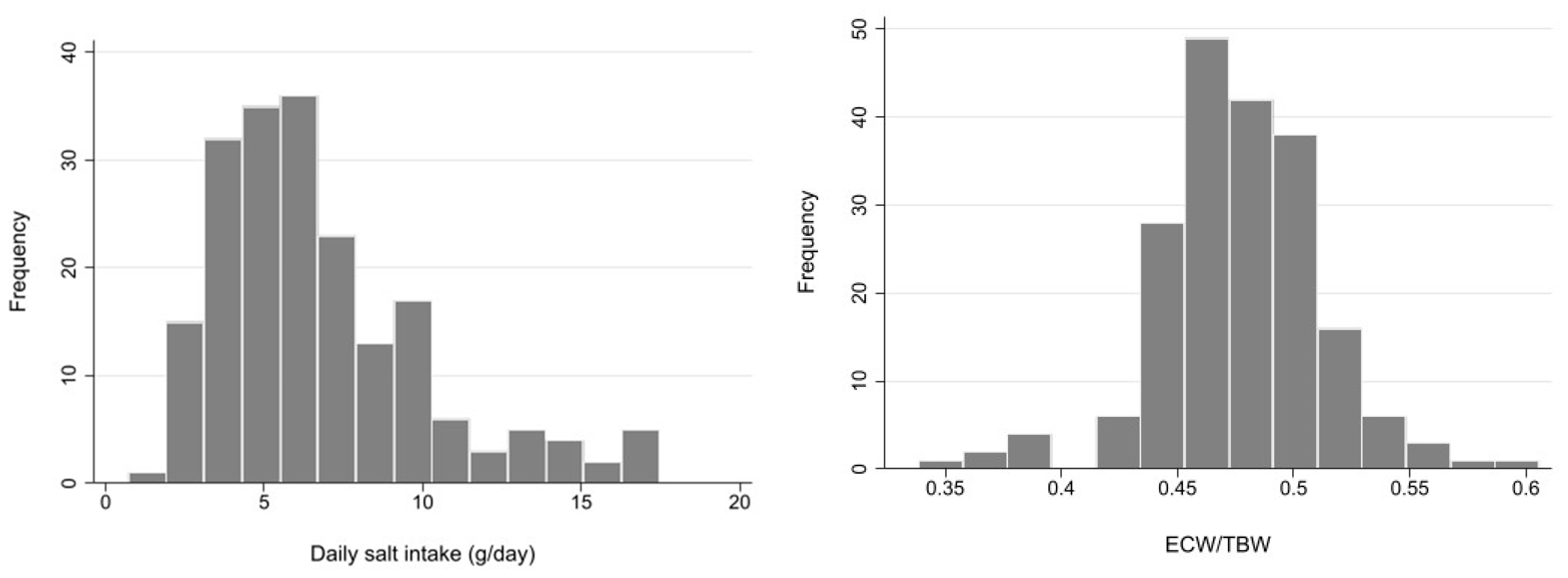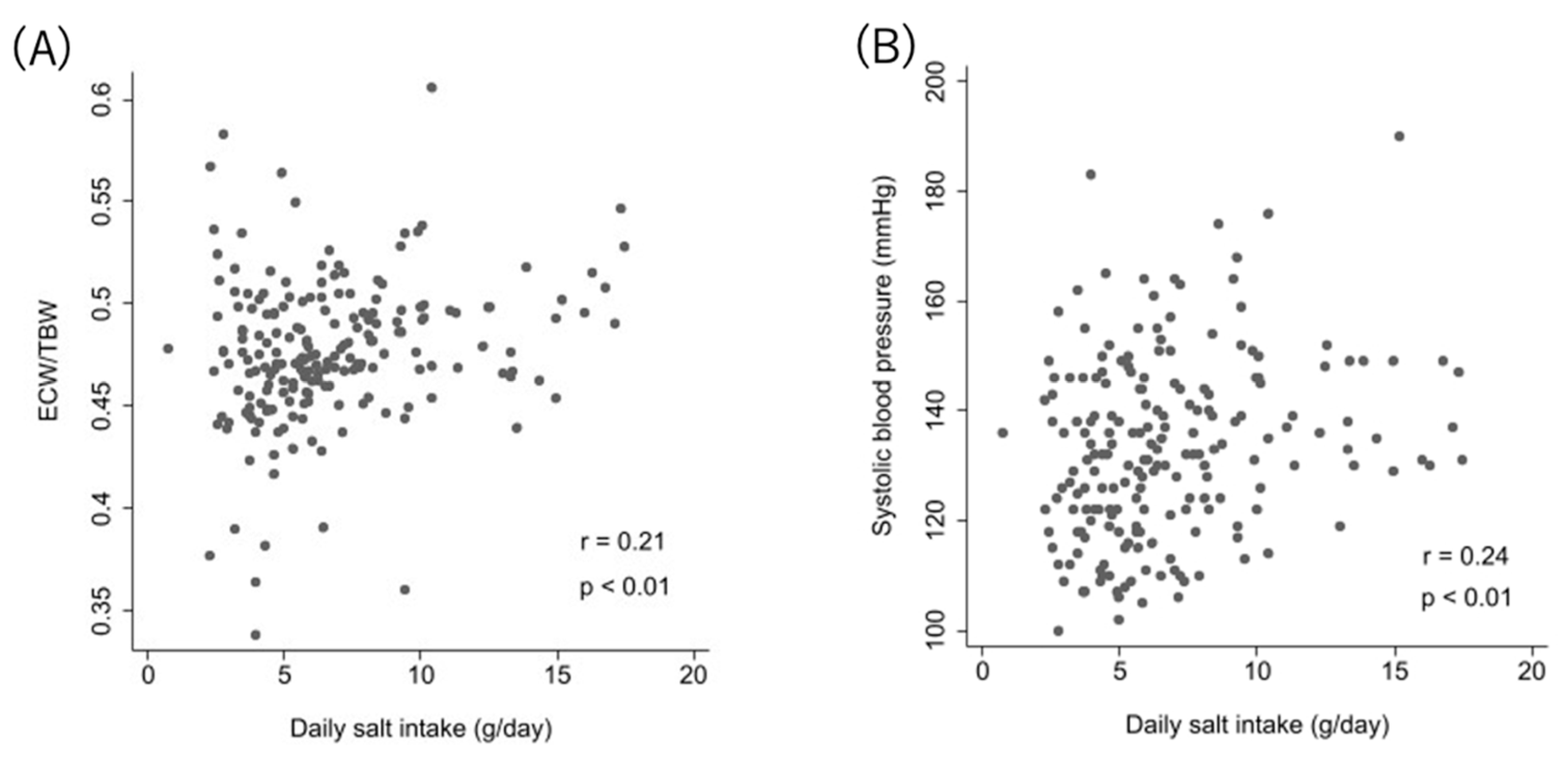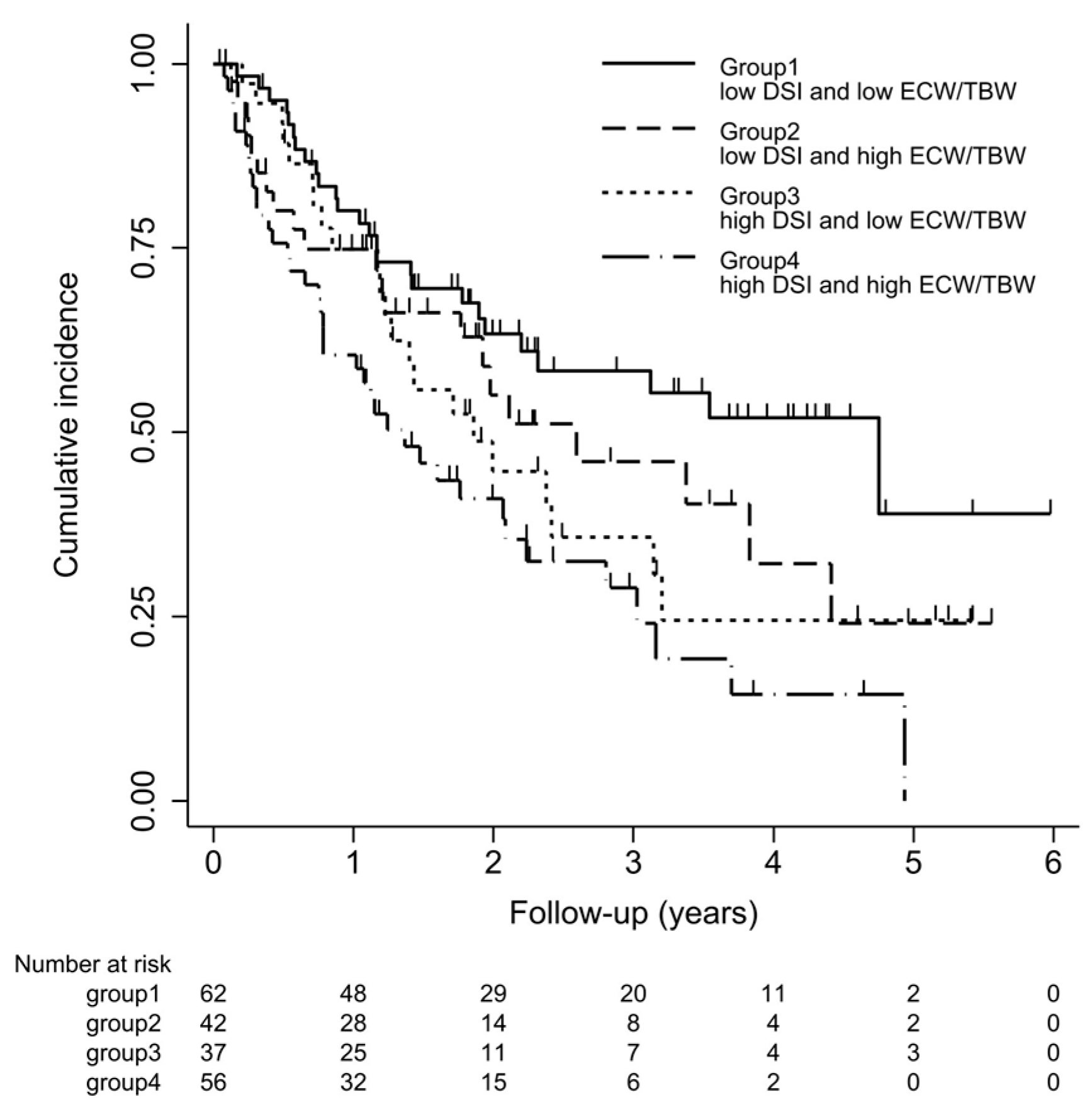Association between Daily Urinary Sodium Excretion, Ratio of Extracellular Water-to-Total Body Water Ratio, and Kidney Outcome in Patients with Chronic Kidney Disease
Abstract
1. Introduction
2. Patients and Methods
2.1. Study Design and Setting
2.2. Study Population
2.3. Measurements
2.3.1. Patient Characteristics
2.3.2. Exposures
2.3.3. Outcomes
2.3.4. Statistical Analysis
3. Results
3.1. Baseline Characteristics
3.2. Patient Outcomes
3.3. Correlation of DSI and Each of ECW/TBW and SBP
3.4. Comparisons of Outcomes among Two Groups According to ECW/TBW or DSI
3.5. Comparison of Clinical Background and Outcomes among Four Groups According to Both ECW/TBW and DSI
4. Discussion
5. Limitations
6. Conclusions
Author Contributions
Funding
Institutional Review Board Statement
Informed Consent Statement
Data Availability Statement
Acknowledgments
Conflicts of Interest
References
- Peleteiro, B.; Lopes, C.; Figueiredo, C.; Lunet, N. Salt intake and gastric cancer risk according to Helicobacter pylori infection, smoking, tumour site and histological type. Br. J. Cancer 2011, 104, 198–207. [Google Scholar] [CrossRef] [PubMed]
- Fatahi, S.; Namazi, N.; Larijani, B.; Azadbakht, L. The association of dietary and urinary sodium with bone mineral density and risk of osteoporosis: A systematic review and meta-analysis. J. Am. Coll. Nutr. 2018, 37, 522–532. [Google Scholar] [CrossRef] [PubMed]
- Ormanji, M.S.; Rodrigues, F.G.; Heilberg, I.P. Dietary recommendations for bariatric patients to prevent kidney stone formation. Nutrients 2020, 12, 1442. [Google Scholar] [CrossRef]
- D’Elia, L.; Rossi, G.; Di Cola, M.S.; Savino, I.; Galletti, F.; Strazzullo, P. Meta-analysis of the effect of dietary sodium restriction with or without concomitant renin–angiotensin-aldosterone system inhibition treatment on albuminuria. Clin. J. Am. Soc. Nephrol. 2015, 10, 1542–1552. [Google Scholar] [CrossRef]
- Campbell, K.L.; Johnson, D.W.; Bauer, J.D.; Hawley, C.M.; Isbel, N.M.; Stowasser, M.; Whitehead, J.P.; Dimeski, G.; McMahon, E. A randomized trial of sodium-restriction on kidney function, fluid volume and adipokines in CKD patients. BMC Nephrol. 2014, 15, 57. [Google Scholar] [CrossRef] [PubMed]
- Hwang, J.H.; Chin, H.J.; Kim, S.; Kim, D.K.; Kim, S.; Park, J.H.; Shin, S.J.; Lee, S.H.; Choi, B.S.; Lim, C.S. Effects of intensive low-salt diet education on albuminuria among nondiabetic patients with hypertension treated with olmesartan: A single-blinded randomized, controlled trial. Clin. J. Am. Soc. Nephrol. 2014, 9, 2059–2069. [Google Scholar] [CrossRef]
- Mills, K.T.; Chen, J.; Yang, W.; Appel, L.J.; Kusek, J.W.; Alper, A.; Delafontaine, P.; Keane, M.G.; Mohler, E.; Ojo, A.; et al. Sodium excretion and the risk of cardiovascular disease in patients with chronic kidney disease. JAMA 2016, 315, 2200–2210. [Google Scholar] [CrossRef]
- Heerspink, H.J.L.; Holtkamp, F.A.; Parving, H.-H.; Navis, G.J.; Lewis, J.B.; Ritz, E.; De Graeff, P.A.; De Zeeuw, D. Moderation of dietary sodium potentiates the renal and cardiovascular protective effects of angiotensin receptor blockers. Kidney Int. 2012, 82, 330–337. [Google Scholar] [CrossRef]
- Wong, M.M.; Arcand, J.; Leung, A.A.; Thout, S.R.; Campbell, N.R.; Webster, J. The science of salt: A regularly updated systematic review of salt and health outcomes (December 2015–March 2016). J. Clin. Hypertens 2017, 19, 322–332. [Google Scholar] [CrossRef]
- He, J.; Mills, K.T.; Appel, L.J.; Yang, W.; Chen, J.; Belinda, T.L.; Rosas, S.E.; Porter, A.; Makos, G.; Weir, M.R.; et al. Urinary sodium and potassium excretion and CKD progression. J. Am. Soc. Nephrol. 2016, 27, 1202–1212. [Google Scholar] [CrossRef] [PubMed]
- Vegter, S.; Perna, A.; Postma, M.J.; Navis, G.; Remuzzi, G.; Ruggenenti, P. Sodium intake, ACE inhibition, and progression to ESRD. J. Am. Soc. Nephrol. 2012, 23, 165–173. [Google Scholar] [CrossRef]
- Fan, L.; Tighiouart, H.; Levey, A.S.; Beck, G.J.; Sarnak, M.J. Urinary sodium excretion and kidney failure in nondiabetic chronic kidney disease. Kidney Int. 2014, 86, 582–588. [Google Scholar] [CrossRef]
- Thomas, M.C.; Moran, J.; Forsblom, C.; Harjutsalo, V.; Thorn, L.; Ahola, A.; Wadén, J.; Tolonen, N.; Saraheimo, M.; Gordin, D.; et al. The association between dietary sodium intake, ESRD, and all-cause mortality in patients with type 1 diabetes. Diabetes Care 2011, 34, 861–866. [Google Scholar] [CrossRef]
- Mazarova, A.; Molnar, A.O.; Akbari, A.; Sood, M.M.; Hiremath, S.; Burns, K.D.; Ramsay, T.O.; Mallick, R.; Knoll, G.A.; Ruzicka, M.; et al. The association of urinary sodium excretion and the need for renal replacement therapy in advanced chronic kidney disease: A cohort study. BMC Nephrol. 2016, 17, 123. [Google Scholar] [CrossRef]
- Zoccali, C.; Moissl, U.; Chazot, C.; Mallamaci, F.; Tripepi, G.; Arkossy, O.; Wabel, P.; Stuard, S. Chronic fluid overload and mortality in ESRD. J. Am. Soc. Nephrol. 2017, 28, 2491–2497. [Google Scholar] [CrossRef] [PubMed]
- Paniagua, R.; Ventura, M.D.; Avila-Diaz, M.; Hinojosa-Heredia, H.; Mendez-Duran, A.; Cueto-Manzano, A.; Cisneros, A.; Ramos, A.; Madonia-Juseino, C.; Belio-Caro, F.; et al. NT-proBNP, fluid volume overload and dialysis modality are independent predictors of mortality in ESRD patients. Nephrol. Dial. Transplant. 2010, 25, 551–557. [Google Scholar] [CrossRef]
- Hung, S.-C.; Kuo, K.-L.; Peng, C.-H.; Wu, C.-H.; Lien, Y.-C.; Wang, Y.-C.; Tarng, D.-C. Volume overload correlates with cardiovascular risk factors in patients with chronic kidney disease. Kidney Int. 2014, 85, 703–709. [Google Scholar] [CrossRef]
- Tsai, Y.C.; Tsai, J.C.; Chen, S.C.; Chiu, Y.W.; Hwang, S.J.; Hung, C.C.; Chen, T.H.; Kuo, M.C.; Chen, H.C. Association of fluid overload with kidney disease progression in advanced CKD: A prospective cohort study. Am. J. Kidney Dis. 2014, 63, 68–75. [Google Scholar] [CrossRef] [PubMed]
- Hung, S.C.; Lai, Y.S.; Kuo, K.L.; Tarng, D.C. Volume overload and adverse outcomes in chronic kidney disease: Clinical observational and animal studies. J. Am. Heart Assoc. 2015, 4, e001918. [Google Scholar] [CrossRef] [PubMed]
- Tai, R.; Ohashi, Y.; Mizuiri, S.; Aikawa, A.; Sakai, K. Association between ratio of measured extracellular volume to expected body fluid volume and renal outcomes in patients with chronic kidney disease: A retrospective single-center cohort study. BMC Nephrol. 2014, 15, 189. [Google Scholar] [CrossRef]
- Matsuo, S.; Imai, E.; Horio, M.; Yasuda, Y.; Tomita, K.; Nitta, K.; Yamagata, K.; Tomino, Y.; Yokoyama, H.; Hishida, A.; et al. Revised equations for estimated GFR from serum creatinine in Japan. Am. J. Kidney Dis. 2009, 53, 982–992. [Google Scholar] [CrossRef] [PubMed]
- McLean, R.M. Measuring population sodium intake: A review of methods. Nutrients 2014, 6, 4651–4662. [Google Scholar] [CrossRef] [PubMed]
- Olde Engberink, R.H.; van den Hoek, T.C.; van Noordenne, N.D.; van den Born, B.J.H.; Peters-Sengers, H.; Vogt, L. Response by olde Engberink et al to Letter Regarding Article, “Use of a Single Baseline Versus Multiyear 24-Hour Urine Collection for Estimation of Long-Term Sodium Intake and Associated Cardiovascular and Renal Risk”. Circulation 2018, 137, 1538–1539. [Google Scholar] [CrossRef] [PubMed]
- Japan Society of Nephrology. Evidence-Based Clinical Practice Guideline for CKD 2018; Igakusha: Tokyo, Japan, 2018; Chapter 3; pp. 17–18. [Google Scholar]
- Aaron, K.J.; Campbell, R.C.; Judd, S.E.; Sanders, P.W.; Muntner, P. Association of dietary sodium and potassium intakes with albuminuria in normal-weight, overweight, and obese participants in the Reasons for Geographic and Racial Differences in Stroke (REGARDS) study. Am. J. Clin. Nutr. 2011, 94, 1071–1078. [Google Scholar] [CrossRef]
- Kang, M.; Kang, E.; Ryu, H.; Hong, Y.; Han, S.S.; Park, S.K.; Hyun, Y.Y.; Sung, S.A.; Kim, S.W.; Yoo, T.H.; et al. Measured sodium excretion is associated with CKD progression: Results from the KNOW-CKD study. Nephrol. Dial. Transplant. 2020, gfaa107, 1–8. [Google Scholar] [CrossRef]
- Kobori, H.; Nishiyama, A.; Abe, Y.; Navar, L.G. Enhancement of intrarenal angiotensinogen in Dahl salt-sensitive rats on high salt diet. Hypertension 2003, 41, 592–597. [Google Scholar] [CrossRef]
- Ying, W.Z.; Sanders, P.W. Dietary salt modulates renal production of transforming growth factor-beta in rats. Am. J. Physiol. 1998, 274, F635–F641. [Google Scholar] [PubMed]
- Meng, S.; Roberts, L.J., II; Cason, G.W.; Curry, T.S.; Manning, R.D., Jr. Superoxide dismutase and oxidative stress in Dahl salt-sensitive and -resistant rats. Am. J. Physiol. Regul. Integr. Comp. Physiol. 2002, 283, R732–R738. [Google Scholar] [CrossRef]
- Shibata, S.; Nagase, M.; Yoshida, S.; Kawarazaki, W.; Kurihara, H.; Tanaka, H.; Miyoshi, J.; Takai, Y.; Fujita, T. Modification of mineralocorticoid receptor function by Rac1 GTPase: Implication in proteinuric kidney disease. J. Clin. Investig. 2011, 121, 323–343. [Google Scholar] [CrossRef]
- Shigeru, S.; Miki, N.; Shigetaka, Y.; Wakako, K.; Kurihara, H.; Tanaka, H.; Miyoshi, J.; Takai, Y.; Takai, Y.; Fujita, T. Modification of mineralocorticoid receptor function by Rac1 GTPase: Implication in proteinuric kidney disease. Nat. Med. 2008, 14, 1370–1376. [Google Scholar]
- Hur, E.; Usta, M.; Toz, H.; Asci, G.; Wabel, P.; Kahvecioglu, S.; Kayikcioglu, M.; Demirci, M.S.; Azkahya, M.; Duman, S.; et al. Effect of fluid management guided by bioimpedance spectroscopy on cardiovascular parameters in hemodialysis patients: A randomized controlled trial. Am. J. Kidney Dis. 2013, 61, 957–965. [Google Scholar] [CrossRef] [PubMed]
- Firth, J.D.; Raine, A.E.; Ledingham, J.G. Raised venous pressure: A direct cause of renal sodium retention in edema? Lancet 1988, 1, 1033–1035. [Google Scholar] [CrossRef]
- Gnanaraj, J.F.; von Haehling, S.; Anker, S.D.; Raj, D.S.; Radhakrishnan, J. The relevance of congestion in the cardio-renal syndrome. Kidney Int. 2013, 83, 384–391. [Google Scholar] [CrossRef]
- Niebauer, J.; Volk, H.D.; Kemp, M.; Dominguez, M.; Schumann, R.R.; Rauchhaus, M.; Poole-Wilson, P.A.; Coats, A.J.; Anker, S.D. Endotoxin and immune activation in chronic heart failure: A prospective cohort study. Lancet 1999, 353, 1838–1842. [Google Scholar] [CrossRef]
- Makoto, A.; Tomota, S.; Noriaki, S.; Kenichiro, A.; Junichi, O.; Kazuaki, J.; Siichi, M. Body water balance in hemodialysis patients reflects nutritional, circulatory, and body fluid status. J. Biorheol. 2018, 32, 46–55. [Google Scholar]
- Titze, J.; Dahlmann, A.; Lerchl, K.; Kopp, C.; Rakova, N.; Schröder, A.; Luft, F.C. Spooky sodium balance. Kidney Int. 2014, 85, 759–767. [Google Scholar] [CrossRef]
- Schneider, M.P.; Raff, U.; Kopp, C.; Scheppach, J.B.; Toncar, S.; Wanner, C.; Schlieper, G.; Saritas, T.; Floege, J.; Schmid, M.; et al. Skin sodium concentration correlates with left ventricular hypertrophy in CKD. J. Am. Soc. Nephrol. 2017, 28, 1867–1876. [Google Scholar] [CrossRef]
- Olde Engberink, R.-H.G.; van den Hoek, T.C.; van Noordenne, N.-D.; van den Born, B.-J.H.; Peters-Sengers, H.; Vogt, L. Use of single baseline versus multiyear 24-h urine collection for estimation of long-term sodium intake and associated cardiovascular and renal risk. Circulation 2017, 136, 917–926. [Google Scholar] [CrossRef]
- Birukov, A.; Rakova, N.; Lerchl, K.; Engberink, R.H.; Johannes, B.; Wabel, P.; Moissl, U.; Rauh, M.; Luft, F.C.; Titze, J. Ultra-long-term human salt balance studies reveal interrelations between sodium, potassium, and chloride intake and excretion. Am. J. Clin. Nutr. 2016, 104, 49–57. [Google Scholar] [CrossRef]




| Variables | Total n = 197 | DSI | p-Value | ||||||||
|---|---|---|---|---|---|---|---|---|---|---|---|
| Low ≦ 6.0 g/day | High ≧ 6.0 g/day | ||||||||||
| ECW/TBW | |||||||||||
| Low ≦ 0.48 n = 62 | High > 0.48 n = 42 | Low ≦ 0.48 n = 37 | High > 0.48 n = 56 | ||||||||
| Age (years) | 70.5 | (12.1) | 73.2 | (13.6) | 72 | (8.6) | 69.8 | (11.5) | 67 | (12.3) | 0.032 b |
| Sex, male (n(%)) | 149 | (75.6) | 43 | (69.4) | 30 | (71.4) | 31 | (83.8) | 45 | (80.4) | 0.30 d |
| Body mass inde (kg/m2) | 24.6 | (4.8) | 22.1 | (3.5) | 26 | (4.7) | 23.7 | (3.3) | 26.9 | (5.4) | <0.001 b |
| Cause of CKD | |||||||||||
| Diabetes mellitus (n(%)) | 62 | (31.5) | 10 | (16.1) | 22 | (52.4) | 8 | (21.6) | 22 | (39.3) | <0.001 d |
| Nephrosclerosis (n(%)) | 55 | (27.9) | 20 | (32.3) | 8 | (19.1) | 12 | (32.4) | 15 | (26.8) | 0.45 d |
| Chronic glomerulonephritis (n(%)) | 24 | (12.2) | 11 | (17.7) | 4 | (9.5) | 4 | (10.8) | 5 | (8.9) | 0.49 d |
| Others (n(%)) | 56 | (28.4) | 21 | (33.9) | 8 | (19.1) | 13 | (35.1) | 14 | (25.0) | 0.28 d |
| Comorbidities | |||||||||||
| Hypertension (n(%)) | 186 | (94.4) | 55 | (88.7) | 39 | (92.9) | 37 | (100) | 55 | (98.2) | 0.005 d |
| Diabetes mellitus (n(%)) | 92 | (46.7) | 18 | (29.0) | 27 | (64.3) | 12 | (32.4) | 35 | (62.5) | <0.001 e |
| Cerebrovascular disease (n(%)) | 65 | (33.0) | 24 | (38.7) | 9 | (21.4) | 16 | (43.2) | 16 | (28.6) | 0.13 e |
| ECW/TBW | 0.48 | (0.04) | 0.45 | (0.03) | 0.5 | (0.03) | 0.46 | (0.02) | 0.5 | (0.02) | <0.001b |
| Laboratory test | |||||||||||
| Hemoglobin (g/dL) | 11.4 | (1.8) | 11.4 | (1.6) | 11.2 | (1.8) | 11.9 | (1.8) | 11.2 | (1.8) | 0.27 b |
| Serum albumin (mg/dL) | 3.9 | (0.5) | 4 | (0.4) | 3.8 | (0.5) | 4 | (0.4) | 3.7 | (0.5) | <0.001 b |
| eGFR (mL/min/1.73m2) | 24.2 | (11.1) | 26 | (10.7) | 23.1 | (10.9) | 24.9 | (11.7) | 22.4 | (11) | 0.29 b |
| 45–59 mL/min/1.73m2 (n(%)) | 8 | (4.1) | 3 | (4.8) | 2 | (4.8) | 1 | (2.7) | 2 | (3.6) | 0.80 d |
| 30–44 mL/min/1.73m2 (n(%)) | 44 | (22.3) | 15 | (4.2) | 9 | (21.4) | 10 | (27.0) | 10 | (17.9) | |
| 15–29 mL/min/1.73m2 (n(%)) | 100 | (50.8) | 35 | (56.5) | 19 | (45.2) | 17 | (46.0) | 29 | (51.8) | |
| <15 mL/min/1.73m2 (n(%)) | 45 | (22.8) | 9 | (14.5) | 12 | (28.6) | 9 | (24.3) | 15 | (26.8) | |
| Urine protein (g/day a) [IQR] | 0.9 | [0.2, 2.2] | 0.5 | [0.1, 1.0] | 0.8 | [0.3, 2.3] | 0.7 | [0.2, 1.8] | 2.2 | [0.9, 4.0] | <0.001 c |
| DSI (g/day a) [IQR] | 5.9 | [4.4, 8.2] | 4.5 | [3.7, 5.4] | 4.2 | [3.2, 5.1] | 7.8 | [6.7, 9.9] | 9.2 | [7.5, 11.2] | <0.001 c |
| Renin-angiotensin inhibitor (n(%)) | 133 | (67.5) | 39 | (62.9) | 31 | (73.8) | 23 | (62.2) | 40 | (71.4) | 0.53 d |
| Diuretics (n(%)) | 62 | (31.5) | 14 | (22.6) | 15 | (35.7) | 5 | (13.5) | 28 | (50.0) | 0.001 e |
| Systolic blood pressure (mmHg) | 133 | (16) | 128 | (16) | 132 | (16) | 132 | (13) | 140 | (17) | <0.001 b |
| Diastolic blood pressure (mmHg) | 74.3 | (8.4) | 72.6 | (8.2) | 72.6 | (8.3) | 76.1 | (7.7) | 76.4 | (8.8) | 0.02 b |
| n | Observed Time (Years) | Incidence | Incident Rate (/100 Person-Year) | [95% CI] | |||||
|---|---|---|---|---|---|---|---|---|---|
| Median | IQR | Total n (%) | ≧30% eGFR Decline n (%) | ESRD n (%) | Death n (%) | ||||
| Total | 197 | 1.4 | [0.7, 2.4] | 107(54.3) | 98(49.7) | 6(3.0) | 3(1.5) | 29.8 | [24.6, 38.0] |
| Group1 | 62 | 1.9 | [1.1, 3.5] | 26(41.9) | 23(37.1) | 2(3.2) | 1(1.6) | 18.7 | [12.7, 27.4] |
| Group2 | 42 | 1.5 | [0.4, 2.3] | 21(50.0) | 21(50.0) | 0 | 0 | 27.9 | [18.2, 42.8] |
| Group3 | 37 | 1.4 | [0.8, 2.4] | 22(59.5) | 18(48.7) | 2(5.4) | 2(5.4) | 32.5 | [21.4, 49.4] |
| Group4 | 56 | 1.1 | [0.4, 2.1] | 38(67.9) | 36(64.3) | 2(3.6) | 0 | 49.2 | [35.8, 67.6] |
Publisher’s Note: MDPI stays neutral with regard to jurisdictional claims in published maps and institutional affiliations. |
© 2021 by the authors. Licensee MDPI, Basel, Switzerland. This article is an open access article distributed under the terms and conditions of the Creative Commons Attribution (CC BY) license (http://creativecommons.org/licenses/by/4.0/).
Share and Cite
Kohatsu, K.; Shimizu, S.; Shibagaki, Y.; Sakurada, T. Association between Daily Urinary Sodium Excretion, Ratio of Extracellular Water-to-Total Body Water Ratio, and Kidney Outcome in Patients with Chronic Kidney Disease. Nutrients 2021, 13, 650. https://doi.org/10.3390/nu13020650
Kohatsu K, Shimizu S, Shibagaki Y, Sakurada T. Association between Daily Urinary Sodium Excretion, Ratio of Extracellular Water-to-Total Body Water Ratio, and Kidney Outcome in Patients with Chronic Kidney Disease. Nutrients. 2021; 13(2):650. https://doi.org/10.3390/nu13020650
Chicago/Turabian StyleKohatsu, Kaori, Sayaka Shimizu, Yugo Shibagaki, and Tsutomu Sakurada. 2021. "Association between Daily Urinary Sodium Excretion, Ratio of Extracellular Water-to-Total Body Water Ratio, and Kidney Outcome in Patients with Chronic Kidney Disease" Nutrients 13, no. 2: 650. https://doi.org/10.3390/nu13020650
APA StyleKohatsu, K., Shimizu, S., Shibagaki, Y., & Sakurada, T. (2021). Association between Daily Urinary Sodium Excretion, Ratio of Extracellular Water-to-Total Body Water Ratio, and Kidney Outcome in Patients with Chronic Kidney Disease. Nutrients, 13(2), 650. https://doi.org/10.3390/nu13020650







